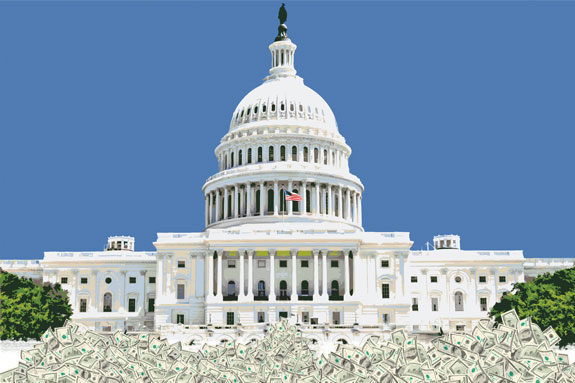Measured in terms of the area affected (parts of the states of Arkansas, Illinois, Kansas, Kentucky, Louisiana, Mississippi, Missouri, Oklahoma, Tennessee and Texas), the number of refugees (over 1.5 million people) and length (it began upstream late 1926 and flood waters did not recede until June 1927), the Great Flood of 1927 ranks as America’s worst natural disaster.
The flooding began in late 1926 when heavy rains hit the tributaries of the upper basin of the Mississippi. The Cumberland River, draining the Southeast watershed, flooded Nashville on New Year’s Day. As these and other tributaries began to pour down the Mississippi and the great river expanded its boundaries, heavy rains hit the southern river basin.
Fifteen inches of rain inundated New Orleans in April. This water blocked passage of the heavy flow from the north, causing the Mississippi to flood over 27,000 square miles.
The response to the humanitarian disaster, unmatched by anything in the nation’s history, permanently reshaped the role of the federal government in the American economy.
President Calvin Coolidge sent his secretary of commerce, Herbert Hoover, to oversee the relief efforts. During the crisis, Hoover mobilized organizations such as the Red Cross, Rockefeller Foundation, local and state governments, state militias and the Army Corps of Engineers.
The entire country paid attention as the disaster unfolded and the relief efforts were made. As a result, Hoover’s name and photograph appeared routinely on nearly every newspaper.
The publicity helped. Although he had never held elected office, Hoover easily won the Republican nomination in 1928 and then the election for president.
Hoover believed that Americans, not the American government, should help other Americans in need. He once remarked, “I suppose I could have called in the Army to help, but why should I, when I only had to call upon Main Street.”
On the other hand, he understood there were some things only the federal government could do. Due in part to his efforts, Congress authorized the Flood Control Act of 1928, which gave the Army Corps of Engineers responsibility to tame the mighty Mississippi.
While the Great Flood of 1927 put Hoover into the White House, the Crash of 1929 eventually took him out. Hoover, ever reluctant to have the government interfere with the markets, instead urged businesses on their own not to lower wages or take other traditional responses to the financial crisis.
The result collapsed the economy even further. In January 1932 he urged Congress to pass the Reconstruction Finance Corporation to provide loans to banks, railroads and insurance companies, a mini predecessor to 2008 Troubled Asset Relief Program.
While his successor, Franklin D. Roosevelt, was considered the father of the farm bills, it was Hoover that first injected the national government into farming when he asked Congress to expand the RFC powers to include making loans directly to farmers, an involvement he saw as temporary.
Roosevelt, not afraid to intervene in the economic system with public money, went further a year later. The Agricultural Adjustment Act of 1933 gave money to farmers outright.
Though this, too, was to be a temporary program, it has survived in one form or another to this day, covering more products, in good years as well as bad. Initially, distribution of payments to farmers was fairly uniform. Farms were nearly universally small family operations.
Since then, as in other sectors, farming units have become both fewer and larger. This concentration has not been uniform. Some regions, particularly the West, have seen much greater concentration while the East and Midwest have retained smaller units.
With this growth in size, the government payments based upon production or acreage became less uniform, with some farmers receiving significantly larger gross payments than others. Congress noticed.
Beginning in 1970, Congress instituted limits on farm payments in one way or another. First, it imposed a maximum payment per program per farm as well as maximum gross payments for all programs.
When it was later disclosed that very wealthy individuals who owned farms more as hobbies than as family income also received payments, Congress added means testing (determining eligibility on income) in 2002.
Over time, as ownership of farm land moved from those on the land to landlords in cities, these payments migrated to non-agrarian zip codes such as those found in Chicago or New York City. The 2008 Farm Bill established tougher requirements for actual involvement in the farm operation, a limit of $500,000 for non-farm gross income and $750,000 on net farm income after expenses.
Today, all commodity payment programs through the Farm Service Agency including MILC payments, are subject to production or payment caps as well as limitations based upon gross farm income or non-farm income. These are commonly called Title I programs.
Support of payment and eligibility limitations comes from diverse groups. Some believe government should not make payments to farmers, period. The political corollary is the lower the limits, the better. Other groups take the position that the government has an obligation to help small farmers, but not larger ones.
This group believes that concentration brings scale and scale brings more profitability and wealth. On the other hand, they argue smaller enterprises are unprofitable without government assistance; the government should protect these farms and they deserve all of the government assistance they can get.
That only small farmers are hurt in tough economic times is a myth. In the Great Dairy Depression of 2009, the hardest-hit victims of the high feed prices and low milk prices were the larger, Western farmers.
Though milk prices were low, it was the high cost of purchased feed which brought the greatest economic stress. Milk producers who grew their own feed stock (generally, but not always, smaller farms) also suffered, but from lower milk prices.
In purely objective terms, the economic losses to dairy production in 2009 corresponded predominantly along with farm size. Scale, rather than protecting against loss, magnified it.
When Congress passed the Dairy Economic Loss Assistance Payment (DELAP) Program, the secretary of agriculture ignored calls from the Western dairies for uncapped payments. Instead, he imposed an arbitrary cap of six million pounds of eligible production (or about 300 cows).
There are now calls for a new safety net program to replace existing dairy programs for all dairymen without caps. A dairy disaster program, if you will.
Among dairy producers, their supporters and others, it is a reasonable demand. Non-uniform payments to producers who are uniformly suffering is a form of wealth transfer from the unpaid to the paid.
Such market intervention favors some producers over others in bidding for replacement animals, feed and other costs. Large dairymen and cooperatives that market their milk are betting on a margin program that will protect them against losses during tough times without caps.
But dairymen will not be the ones to draft final legislation and if any payment program survives Congress, it will be capped.
Three of the most powerful groups are aligned on this issue. Those congressmen and senators opposed to any farm payments (and there are substantial numbers of those in Congress) will see lower payments on less and less production the less evil of the options. Caps on payments do just that.
Supporters of payments to the small farm only argue that in an uncapped program, 5 percent of dairy farms would receive over 60 percent of the money. On the flip side, less money can do more good for the 90 percent of the 62,000 milk producers (read more voters) who produce 25 percent of milk on the smaller farms.
Finally, whether farm programs, capped or uncapped, are good, bad or indifferent, Congress has no money to fund them. With a national debt north of $14 trillion and annual deficits in excess of $1 trillion, deficit hawks, a growing flock, believe that terminating these programs, as well as others, is necessary to protect the national fiscal solvency.
In the face of these extraordinary headwinds, there is also legislative strategy. The MILC program and the proposed margin insurance program are both “Title I” programs operated by the Farm Service Agency (FSA). Title I programs, by law, are subject to a variety of payment limitations.
Congress would have to expressly and openly exempt a dairy program from caps. That, in the best of worlds, is very unlikely.
In Washington-think, programs are valued relative to the “baseline.” Proposals at or below baseline are easier to continue than programs that exceed it. The Congressional Budget Office (CBO) uses economic models to compute the baseline using the law in effect on the day before the period begins, or October 1, 2012.
The MILC program now pays 45 percent of the positive difference between the Boston Class I price and $13.69 cwt as adjusted for feed costs, on up to 3.4 million pounds. But for September 2012, that drops to 35 percent, no adjuster, and capped at 2.9 million pounds.
The CBO baseline is not out yet, but USDA estimates that for FY 2012, MILC will cost only $120 million, primarily for FY 2011 production. USDA projections indicate almost no MILC payments thereafter. That means a very low baseline.
Adding money from a terminated Dairy Product Price Support Program will help little. Over the life of a prospective 2012 Farm Bill, current USDA projections show no period where prices will be low enough to trigger price support purchases.
In short, restoring MILC to its current level will risk exceeding the baseline, leaving little money for a new uncapped program for the remaining 60 percent milk. All of this is before the expected application of across-the-board reductions in baselines.
Additionally, proposals to reduce gross non-farm income to $200,000 per year and gross farm income to as low as $350,000 makes it highly unlikely that a dairy program that pays all producers on production, regardless of production, will survive the Congress.
Even without caps, the government does not have the power to truly cover all economic losses. In 2009, had Congress required uncapped payments, the rate would have been about 25 cents per hundredweight on one year’s milk production, that in a year when the real losses were in dollars, not cents.
As this article is being written, the Flood Control Act of 1928 is being tested. After eight decades of attempting to tame the mighty Mississippi, the Corps of Engineers has been forced to open spillways and flood hundreds of thousands of acres of rich farm ground and the towns that supported agriculture to save the cities.
Tens of thousands of individuals are being forced to leave their homes. Even then, the record waters are too high, with cities like Memphis and Vicksburg experiencing unprecedented flooding. Proving again that when all cannot be saved, some win and some lose. PD

-
Ben Yale
- Attorney
- Yale Law Offices
- Email Ben Yale







